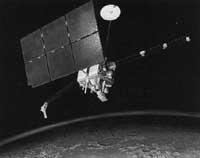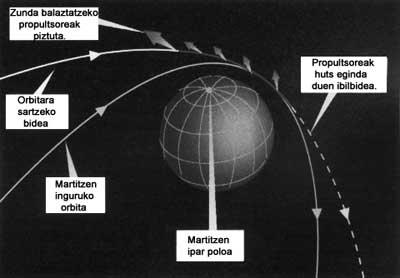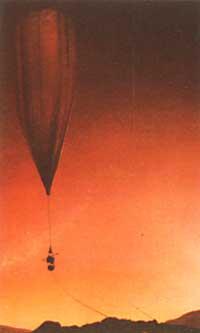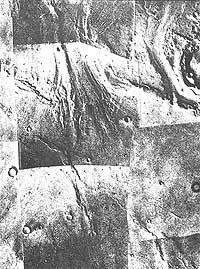Mars Observer has a substitute
1993/11/01 Arregi Bengoa, Jesus Iturria: Elhuyar aldizkaria
On 21 August DNA technicians lost communication with the Mars Observer space. DNA has three stations in Australia, Spain and the United States to track any object 24 hours a day, but all efforts have been futile. The contact was interrupted when the final technicians tried to put the space in orbit around Mars. To carry out this maneuver, they had to stop the space, putting pressure on the fuel tank. Due to the dangers of this task, all space systems went out. Since then no response has been obtained from Mars Observer.
After eleven months the space was about to reach its destination, the loss is more evident. Mars Observer was launched in September last year, although it was originally intended to be launched two years earlier. This delay was the result of the stop caused by the Challenger accident in 1986. The Observer was not launched through a space launcher like the Challenger, as originally thought, but using the pitcher Titan. Shortly after launch the communication was interrupted for an hour, but then there was no problem until weeks before the day it was completely cut off.

Early studies indicate that the unit controlling all Mars Observer functions was damaged. The same day that Mars Observer was lost, communication was also interrupted with a weather satellite put into orbit fifteen days earlier. It seems that both ships have been lost by the same mistake: some badly welded transistors.
When programs have been planned as difficult and costly as the Mars Observer program, two spaces have been sent so that the problem occurred last August would not waste the program. So did the DNA in its last program Martitz in 1975, with the sending of twin Viking-1 and Viking-2 probes. On this occasion, due to budgetary constraints, it was decided to send a single one. However, in the Senate Board in charge of this issue, the work of the DAP has been strongly committed to bringing together in a single probe so many valuable programs.
Mars Observer probably did not perform the braking maneuver and did not enter the orbit of Mars. Nor is it considered that the system designed to automatically host this orbit has fulfilled its work. Consequently, the amount of money spent on the mission will move like an artificial asteroid around the Sun in some orbit between Martitz and Jupiter. Of course, the Observer ship is too small to track with optical telescopes and radio telescopes. Therefore, we will never know what the probe is.
As mentioned above, Mars Observer was provided with a variety of tools. Its objectives were very broad. It had to surround the planet at a height of 374 km. In addition to the camera he carried a laser altimeter to make the most accurate map possible. It also had radioactive spectrometers, neutron emission and infrared emission, as well as temperature sensors and amount of dust and water vapor contained in the atmosphere. Although Mars had a magnetic field, Mars Observer had a magnetometer to measure its magnitude.
Among other things, it was a matter of clarifying the mineral wealth of Mars, the climatic circumstances and whether there has ever been water. The problem we have just mentioned is of utmost importance in order to become unaware of whether there has been any life on Mars. The erosion indicators that can be found in the Martian landscape would show that at some previous time the climate has been humid. If things like that happened, possible ice accumulations would be the best place to find the traces of life.
In any case, all these measurements should expect a better opportunity, perhaps the one that can offer the new program designed by DAP scientists. At the end of September D. Goldin, director of DNA, presented to Congress the need to address this new program and the costs it will generate. You may think it is working very fast and so, but there is an important reason that makes this hurry necessary. The launch of the spaces destined for Mars must be the most suitable so that the relative position of Earth and Mars is as short as possible the journey and the probe finds the least number of obstacles possible. This situation only occurs once every 26 months and the next will be in October next year. Therefore, by then you must be prepared. If not, wait more than two years.
We always know what is the biggest problem to get the project forward: the budget. Regardless of the launch, the program could cost at least $150 million. If a Delta projector was needed to launch the probe, an additional $60 million would be needed. A more economical solution would be the use of Russian launcher, but it seems that crossing international borders would cause major problems. However, all details will be resolved shortly for the aforementioned reason.

EPHEMERISSUN: on November 22 at 7h 6min (UT) enters Sagittarius.
Total eclipse of the moon: on the day of the moon we will have a total eclipse of the moon visible from Euskal Herria. The fullness phase starts at 6h 2min (UT) and ends at 6h 50min (UT). Due to the light of dawn, we will not be able to see the eclipse until the Moon comes out of the light and ends completely. PLANETS MERCURY: November is a month of special importance to see Mercury. Day 22 reaches its west elongation. Therefore, that day and those around us can see you in the morning, in the best conditions all year round. On the other hand, day 6 Mercury is in lower conjunction and passes in front of the solar disk. However, this interesting transit is not seen from Euskal Herria, |

Gai honi buruzko eduki gehiago
Elhuyarrek garatutako teknologia






